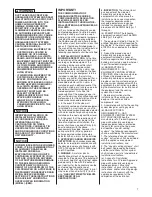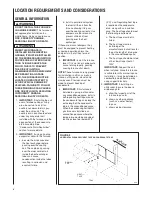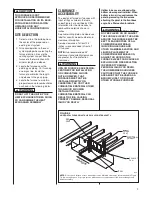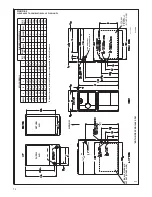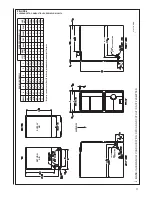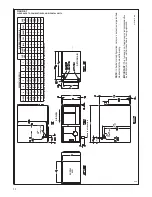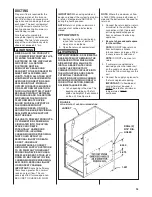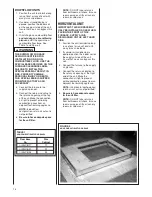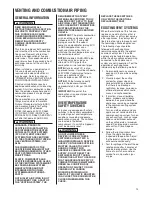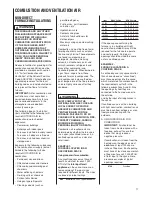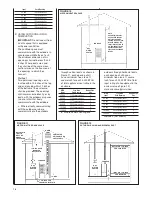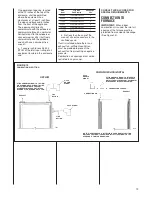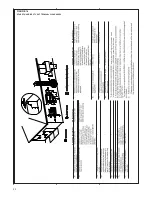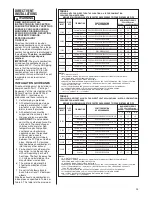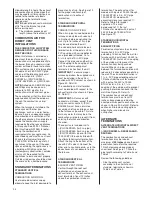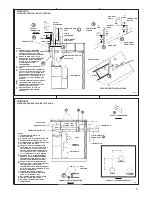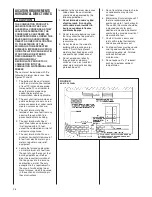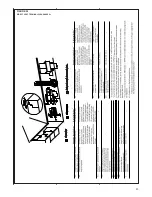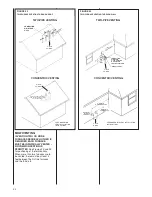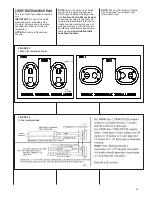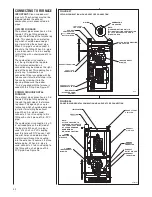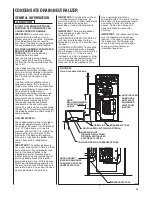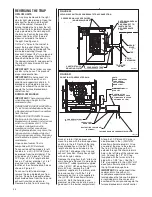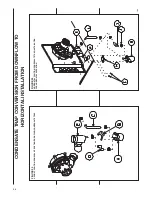
21
STANDARD INSTALLATIONS
The single-pipe system requires an
exhaust pipe only. Combustion air may
be taken from the furnace installation
area or ducted to the furnace area from
the outside.
Size the exhaust pipe as specified in
Table 2. This table lists the maximum
allowable length in feet of the exhaust
pipe that may be used for all furnace
inputs as related to the number of
elbows required and the termination.
(See shaded area.)
Vertical through-the-roof installations do
not require a vent termination. Use 2-in.
PVC pipe extending a minimum of 12
inches above the anticipated level of
snow accumulation. See exhaust pipe
requirements, Figure 19. When 3-in.
vent pipe is used from furnace to the
roof, reduce it to 2 inches before
penetrating the roof. A maximum of 18
inches of 2-in. pipe may be used below
the roof. Maximum exposed vent length
above the roof line is 30”. Total 2” vent
length is a maximum of 48”.
Horizontal vent terminations require a
2-in. PVC tee positioned 12 inches from
the outside wall. See exhaust pipe
requirements, Figure 29. When 3-in.
pipe is used from the furnace to the
outside wall, reduce it to 2 inches
before penetrating the wall. A maximum
of 18 inches of 2-in. pipe may be used
inside the wall.
An alternate termination may be used
as shown in Figure 15 to clear
anticipated snow levels. The tee may
be raised up to 24 inches above the
wall penetration. Use two long-sweep
radius bend, 2-in. PVC elbows and a
length of 2-in. PVC pipe so that the
elbows are on 24-in. centers.
NOTE:
Extend the exhaust a minimum
of 18" from the furnace top plate before
turning vent.
NON-DIRECT VENT TERMINATION
LOCATION REQUIREMENTS
MOISTURE IN THE COMBUSTION
PRODUCTS CONDENSES AS IT
LEAVES THE TERMINATION. THIS
CONDENSATE CAN FREEZE ON
EXTERIOR WALLS, UNDER THE
EAVES, AND ON SURROUNDING
OBJECTS. SOME DISCOLORATION
IS TO BE EXPECTED. HOWEVER,
IMPROPER LOCATION OR
INSTALLATION CAN CAUSE
STRUCTURAL OR EXTERIOR FINISH
DAMAGE TO THE BUILDING.
Non-direct venting location
requirements are slightly different in
some cases than direct venting. Install
a non-direct vent with the following
minimum clearances.
See Figure 16.
1. Locate the bottom of the vent
terminal at least 12 inches above
grade. Increase the 12-in.
minimum to keep the terminal
openings above the level of snow
accumulation, where applicable.
2. The vent shall not terminate over
public walkways or over an area
where condensate or vapor could
create a nuisance or hazard.
3. 4 feet below, 4 feet horizontally
from, or 1 foot above any door,
window soffit, under eave vent or
gravity air inlet to the building.
4. The vent terminal shall have a
minimum horizontal clearance of
4 feet from electric meters, gas
meters, regulators and relief
equipment.
5. 6 feet from an inside corner
formed by two exterior walls –
10 feet is the recommended
distance.
6. Locate it 3 feet above any forced
air inlet located within 10 feet.
Any fresh air or make-up air inlet,
such as for a dryer or furnace
area, is considered a forced air
inlet.
7. Avoid areas where dripping
condensate may cause problems,
such as above planters, patios, or
adjacent to windows where
steam may cause fogging.
!
CAUTION
In addition to the minimum clearances
listed above, the vent location should
also be governed by the following
guidelines.
1. Do not terminate under any kind
of patio or deck. If running the
vent under a deck, insulate it to
insure no condensate freezes
and blocks the pipe.
2. Do not locate on the side of a
building with prevailing winter
winds. This will help prevent
moisture from freezing on walls
and overhangs (under eaves).
3. Do not extend vent directly
through brick or masonry
surfaces. Use a rust-resistant
sheet metal or plastic backing
plate behind vent.
4. Do not locate too close to shrubs
as condensate may stunt or kill
them.
5. Minimum vertical clearances of 1
foot are recommended for
overhangs up to 1 foot horizontal.
The vertical clearance should be
increased equally for each
additional increase in horizontal
overhang to a maximum vertical
clearance of 6 feet.
6. Caulk all cracks, seams and
joints within 6 feet horizontally
and above and below vent.
7. Do not terminate in any area that
may allow flue gases to stagnate.
FIGURE 15
ALTERNATE HORIZONTAL TERMINATION
FOR NON-DIRECT VENT
INSTALLATIONS
NOT APPLICABLE FOR:
(-)GRL-07EYBGS MODEL
(-)GRL-07EMAES MODEL
(-)GRL-10EZAJS MODEL
12"
FRO
M
24"
MAX.
PIPE
SUPPORT
STRAP
OUTSIDE
WALL
I198
Summary of Contents for RGRK SERIES
Page 41: ...41 FIGURE 39 TYPICAL MANIFOLD PRESSURE READING...
Page 45: ...45 FIGURE 43 UT Electronic Controls 1095 201 IFC TWINNING CONNECTION SINGLE STAGE OPERATION...
Page 60: ...60 FIGURE 53 TROUBLESHOOTING CHART or IFC not properly grounded Go To Next Page...
Page 61: ...61 FIGURE 53 TROUBLESHOOTING CHART CONTINUED...
Page 62: ...62 FIGURE 54 WIRING DIAGRAM...
Page 63: ...63...
Page 64: ...64 CM 0510...

